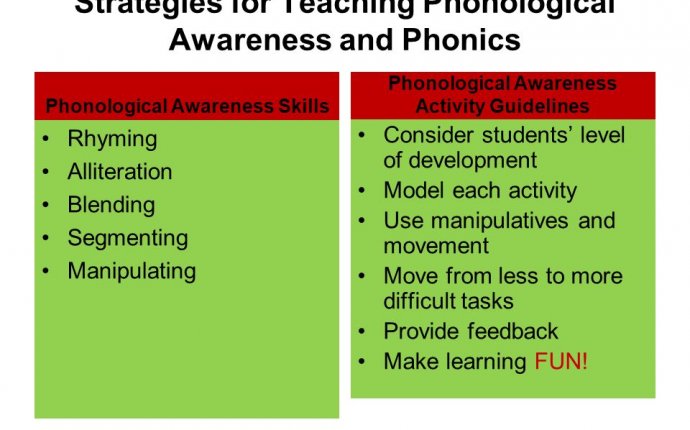
Strategies for teaching phonological awareness
How to Teach Phonological Awareness
Just like phonics skills, there is a developmental sequence to teaching phonological awareness skills. Teaching phonological and phonemic awareness is done in the absence of written text.
An in-depth assessment, such as the Comprehensive Test of Phonological Processing (CTOPP), will help you determine your student’s present level of functioning and set developmentally appropriate goals. Below is the developmental progression of phonological processing skills, followed by specific activities.
Early Developing Skills
- Rhyming Counting/manipulating words in sentences
- Counting syllables
- Sound-matching
- Identifying initial phoneme in a word
- Identifying final phoneme in a word
- Identifying the medial sound in a word
- Discriminating (same or different) words and phonemes
- Blending and segmenting syllables (cow+boy)
Later Developing Skills (words are generally 2-4 phonemes long)
- Adding or subtracting the initial, final, or medial sounds in words
- Counting the number of phonemes in a word
- Substituting sounds in words (on becomes in)
- Shifting sounds in words (ask becomes aks)
- Repeating sounds in words (kis becomes kiks)
- Blending real and nonsense words
Advanced Skills
- Adding, subtracting, or re-arranging prefixes and suffixes for multisyllabic words
Later Developing Skills with 5+ Phonemes
Special Notes for Phonological Awareness: When you are teaching phonological awareness, it is important for students to understand that this is NOT phonics. You will need to begin at the meta-cognitive level and then help your student to learn that he is counting the sounds, not the letters, in a word. If you are working with a visual learner, it may help him to visually represent words, syllables, or phonemes with some sort of manipulative (e.g., different colored felts, blocks, papers, etc). A kinesthetic learner may benefit from tapping, clapping, jumping, moving hands together (for blending) and moving them apart for (segmenting).
Begin each lesson with a level that your student has mastered and then give easy examples of a new skill or a word with one additional phoneme. Have the student follow your model and gradually increase the length and complexity. End with a different type of phonological task. Remember, phonological awareness tasks need not be boring. A board game or picture flashcards (sorted by the number of phonemes in the word) may be transformed into a phonological awareness game. Experiment with nonsense words. Ask your student to try to "stump" the teacher. Movement makes phonological exercises more engaging.
We highly recommend Louisa Cook Moats' book Speech to Print: Language Essentials for Teachers (Brookes Publishing, 2010, 2nd edition). Dr. Moats does a superb job connecting oral language to all aspects of print. The tutorial format of the book provides both comprehensive, understandable descriptions as well as concrete examples of the oral language connections.
Phonological awareness is different from phonics (and includes phonemic awareness) and is an essential skill to learn to read. Therefore, it is critical to make this concept explicit for all students with dyslexia. Developmentally appropriate phonological awareness goals should be incorporated into your student's IEP. Instruction should begin with meta-cognition and should be targeted to your student's learning style. Fun activities should allow for mastery and also challenge the student by incrementally increasing the number of phonemes and difficulty of task. Your intervention in this area will help your student with dyslexia to build up the neuro-pathways that are weak and will set him up for success with reading and writing! Success starts here!








